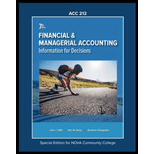
(a)
To identify:
Company which is most profitable according to its return on assets.
Return on Total Assets Ratio:
Measurement of a company’s earnings against its net assets is known as return on total assets ratio.
Debt and Equity Ratio:
Debt equity ratio is incorporated with debt and equity or shareholder’s equity used in the company. This financial ratio represents share of ‘debt’ which includes short term debt as well as long term debt and ‘equity’.
(b)
To identify:
Most risky company according to the debt ratio.
Explanation:
- Debt ratio of S, A and G Company is 26.1%, 58.9% and 18.4% respectively.
- Higher the ratio more risky will be the company.
- Here A Company has the highest ratio which shows high risk.
Thus, A Company is the most risky company according to debt ratio.
(c)
To identify:
Company deserves increased investment based on a joint analysis of return on assets and debt ratio.
Explanation:
- A Company is a more risky company since it has the highest debt equity ratio as compared with S Company and G Company.
- Whereas G Company has the lowest debt equity ratio as compared with A Company and S Company.
- These two ratios are entirely different on the basis of which comparison is quite incomplete.
Hence, these ratios do not tell about the investment related aspects.
(c)
To identify:
Company deserves increased investment based on a joint analysis of return on assets and debt ratio.
Want to see the full answer?
Check out a sample textbook solution
Chapter 2 Solutions
FIN & MANAGERIAL ACCT VOL 2 W/CONNECT
- During the month of November, Luffee Company had cash receipts of $5,100 and paid out $1,300 for expenses. The November 30th cash balance was $7,200. What was the cash balance on November 1?arrow_forwardLakeside Ltd. started August with a cash balance of $50,000. It collected $10,000 during the month and made cash disbursements totalling $22,000. What is the cash balance on August 31? A. $38,000 debit B. $40,000 credit C. $62,000 debit D. $38,000 creditarrow_forwardcan you help me with this General accounting questionarrow_forward
- AWQ Inc. was incorporated two years ago by issuing 5,000 shares of common stock at $400 each and borrowing $240,000 from a bank on a long-term note. Last year, AWQ reported net income of $20,000 and paid a cash dividend of $1,800. Last year, the company also borrowed an additional $320,000 from the bank. What was the total assets on AWQ's balance sheet at the end of the year last year?arrow_forwardprovide correct answer General accounting questionarrow_forwardPART 2. (22 marks) Mangal Furnishings produce serving trays for the tourist industry in a five-stage process - Cutting & Shaping, Assembly, Sanding, Finishing and Packaging. Upon entering the finishing process, before the trays are stained and polished, a specialized piece of equipment is used to engrave a logo on each tray. After Packaging, the trays are sent to the business warehouse for delivery to customers. The following data relates to the Finishing Process for the month of March during which 3,800 trays valued at $597.90 each were transferred in from the Sanding Process. Other production costs incurred during the month are summarized as follows: Direct Materials Added Direct Manufacturing Wages Hireage cost of specialized logo equipment Manufacturing Overhead $343,380 $830,150 $21,300 $412,100 Process inspection occurs during the process and normally 2% of the trays entering the Finishing process are rejected and sold as scrap to local retailers at $750 each. During the month…arrow_forward
- Equipment that costs $110,000 and on which $50,000 of accumulated depreciation has been recorded was disposed of for $70,000 cash. Recording this event would include an: A. gain of $10,000 B. A loss of $5,000. C. Increase to accumulated depreciation for $15,000 D. Decrease to equipment for $15,000.arrow_forwardGeneral accounting questionarrow_forwardFinancial Accountingarrow_forward

 AccountingAccountingISBN:9781337272094Author:WARREN, Carl S., Reeve, James M., Duchac, Jonathan E.Publisher:Cengage Learning,
AccountingAccountingISBN:9781337272094Author:WARREN, Carl S., Reeve, James M., Duchac, Jonathan E.Publisher:Cengage Learning, Accounting Information SystemsAccountingISBN:9781337619202Author:Hall, James A.Publisher:Cengage Learning,
Accounting Information SystemsAccountingISBN:9781337619202Author:Hall, James A.Publisher:Cengage Learning, Horngren's Cost Accounting: A Managerial Emphasis...AccountingISBN:9780134475585Author:Srikant M. Datar, Madhav V. RajanPublisher:PEARSON
Horngren's Cost Accounting: A Managerial Emphasis...AccountingISBN:9780134475585Author:Srikant M. Datar, Madhav V. RajanPublisher:PEARSON Intermediate AccountingAccountingISBN:9781259722660Author:J. David Spiceland, Mark W. Nelson, Wayne M ThomasPublisher:McGraw-Hill Education
Intermediate AccountingAccountingISBN:9781259722660Author:J. David Spiceland, Mark W. Nelson, Wayne M ThomasPublisher:McGraw-Hill Education Financial and Managerial AccountingAccountingISBN:9781259726705Author:John J Wild, Ken W. Shaw, Barbara Chiappetta Fundamental Accounting PrinciplesPublisher:McGraw-Hill Education
Financial and Managerial AccountingAccountingISBN:9781259726705Author:John J Wild, Ken W. Shaw, Barbara Chiappetta Fundamental Accounting PrinciplesPublisher:McGraw-Hill Education





